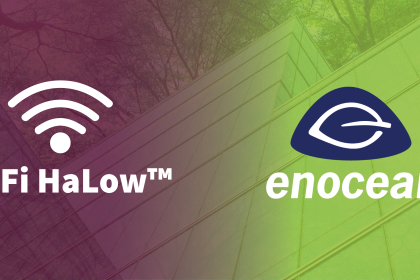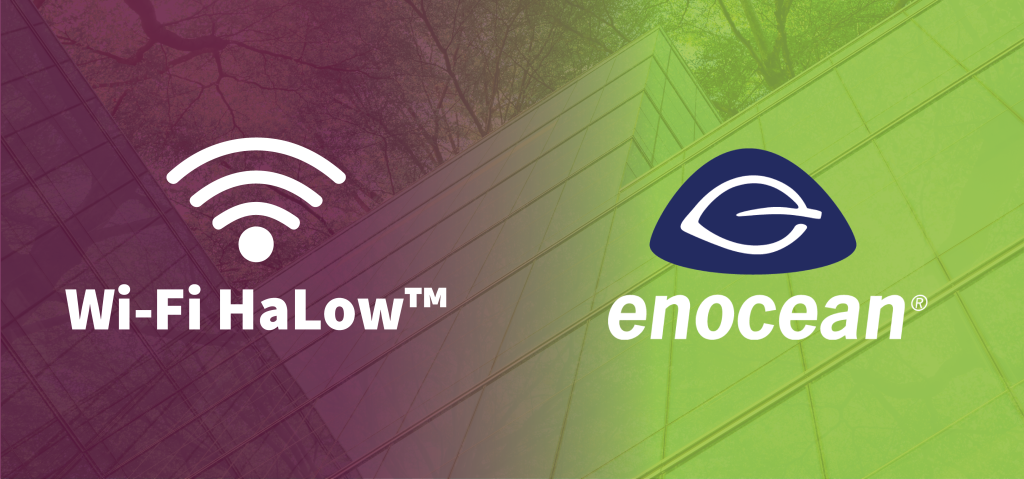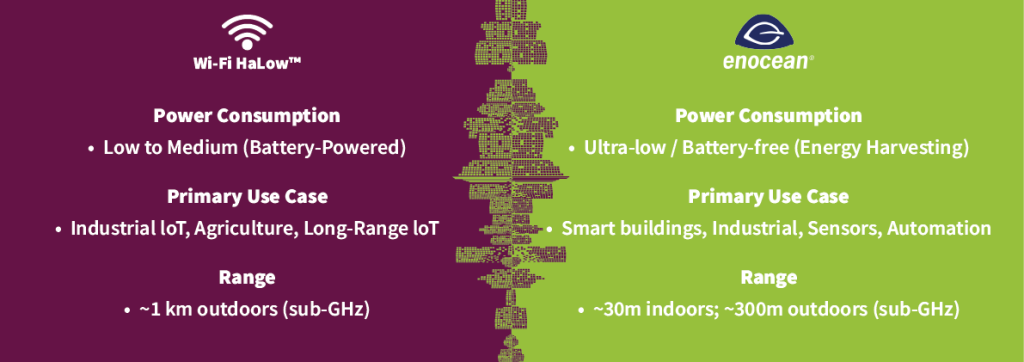

Why Compare Wi-Fi HaLow and EnOcean?
As the Internet of Things (IoT) expands, comparing wireless standards like Wi-Fi HaLow vs EnOcean becomes essential. These two technologies frequently surface in conversations about smart, sustainable connectivity—but they serve different purposes. While some may assume that Wi-Fi HaLow could replace EnOcean, the reality is far more nuanced.
Wi-Fi HaLow and EnOcean are not interchangeable. They’re designed to address different needs and environments. Understanding how they differ—and how they can work together—helps integrators, solution designers, and end users choose the most suitable tools for modern IoT applications.
Understanding Wi-Fi HaLow
Wi-Fi HaLow supports long-range, moderate-bandwidth communication—particularly in industrial, agricultural, and outdoor applications. Operating in the sub-GHz band (around 900 MHz), it offers better wall penetration and reduced interference compared to 2.4 GHz or 5 GHz Wi-Fi.
However, it’s important to understand that HaLow is not traditional Wi-Fi:
- Different Hardware: Wi-Fi HaLow uses a completely different radio and hardware stack from conventional Wi-Fi. It’s incompatible with existing Wi-Fi networks and routers, and unlikely to be supported by future standard Wi-Fi infrastructure.
- Extended Range via Higher Power: To achieve its long-range capability, HaLow can boost output power up to 25 mW (14 dBm), or even 125 mW (21 dBm) in some implementations. It also decreases the data rate, which makes it more stable over distance.
- Battery Life Trade-Off: This comes at a cost: higher power consumption. Although often positioned as “low power,” Wi-Fi HaLow requires far more energy than EnOcean. Devices sending even small packets a few times an hour can burn through batteries in months—or just a few years—depending on conditions.
- Regulatory and Market Constraints: Launched in 2017, Wi-Fi HaLow has only recently appeared in shipping products. Furthermore, its claimed range of up to 10 km is rarely permitted in many European and Asian regions due to spectrum regulations.
As a result, Wi-Fi HaLow can be a great fit for outdoor, bandwidth-sensitive IoT use cases. Nevertheless, it remains less suitable for ultra-low-power, maintenance-free indoor environments.
EnOcean: Ultra-Low-Power and Proven
EnOcean has been around since 2001 and specializes in wireless, battery-free communication for smart buildings and industrial automation. Its devices operate using harvested energy—from motion, light, or heat—and transmit tiny data packets using only a few milliwatts for milliseconds. This makes them especially well-suited for low-maintenance, energy-conscious environments where infrastructure flexibility and operational longevity are essential.
This enables:
- Battery-Free Installations: No maintenance, no replacement.
- Scalability: Ideal for dense sensor networks indoors.
- Interoperability: Supported by a mature alliance with over 5000 interoperable devices.

Why They’re Better Together
Instead of viewing Wi-Fi HaLow and EnOcean as competitors, consider the power of a hybrid deployment:
- Use EnOcean for battery-free sensors, switches, and controls in buildings.
- Use HaLow where longer range or more data is required—like external cameras or field sensors.
In this way, both technologies serve distinct roles and can work side by side to build resilient, flexible, and energy-efficient systems.
Conclusion: The Smart Choice Is a Complementary One
In the smart technology space, one size doesn’t fit all. While Wi-Fi HaLow is promising for wide-area IoT applications, it is not a drop-in replacement for EnOcean.
EnOcean continues to lead in delivering ultra-low-power, battery-free solutions for smart buildings and automation environments. It’s not just about bandwidth or distance—it’s about sustainability, maintainability, and long-term value.
Ultimately, the Wi-Fi HaLow vs EnOcean decision comes down to choosing the right tool for the job.
To learn more, contribute, or explore collaboration opportunities, visit www.enocean-alliance.org.
Wi-Fi® and Wi-Fi HaLow™ are registered trademarks of the Wi-Fi Alliance®. EnOcean® is a registered trademark of EnOcean GmbH.



 Deutsch
Deutsch  简体中文
简体中文  Français
Français  Italiano
Italiano  日本語
日本語 
